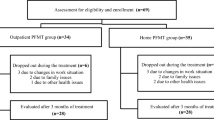Abstract
Introduction and hypothesis
In our previous single-arm pilot study, we reported that ready-made supportive underwear (shaper) was effective in elevating the bladder neck and reducing urinary incontinence (UI) symptoms. The aim of this study was to determine the effects of wearing a shaper compared with pelvic floor muscle training (PFMT) at home using a training compact disc with music, or no treatment, in an assessor-blinded randomized control trial, on reducing UI symptoms.
Methods
Participants aged 30–59 years with symptoms of stress urinary incontinence were randomly assigned to three groups: the shaper group, PFMT group, and no treatment group. The UI episodes/week and the Japanese version of the International Consultation on Incontinence Questionnaire Short-Form were compared between the baseline and the 6th or 12th week of the intervention period.
Results
Eighty-nine women who completed the 12-week intervention period were analyzed. After the 12-week intervention period, the improvement rate in UI symptoms (ratio of the case number in which the UI episodes/week decreased at least 50% from the baseline) was 73.3% (22/30 women) in the shaper group, 74.2% (23/31 women) in the PFMT group, and 25.0% (7/28 women) in the no treatment group. The improvement rate in UI symptoms in the shaper and PFMT groups was significantly higher than that in the no treatment group (both P < 0.001).
Conclusions
Wearing supportive underwear (shaper) was almost as effective as PFMT at home in reducing UI symptoms.


Similar content being viewed by others
References
Ninomiya S, Naito K, Nakanishi K, Okayama H. Prevalence and risk factors of urinary incontinence and overactive bladder in Japanese women. LUTS. 2017. https://doi.org/10.1111/luts.12185.
Zhang L, Zhu L, Xu T, Lang J, Li Z, Gong J, et al. A population-based survey of the prevalence, potential risk factors, and symptom-specific bother of lower urinary tract symptoms in adult Chinese women. Eur Urol. 2015;68:97–112.
Riss P, Kargl J. Quality of life and urinary incontinence in women. Maturitas. 2011;68:137–42.
Nishizawa O, Ishizaki O, Okamura K, Gotoh M, Hasegawa T, Hirao Y. Guidelines for management of urinary incontinence. Int J Urol. 2008;15:857–74.
Oliveira M, Ferreira M, Azevedo MJ, Firmino-Machado J, Santos PC. Pelvic floor muscle training protocol for stress urinary incontinence in women: a systematic review. Rev Assoc Med Bras. 2017;63:642–50.
Zanetti MRD, Castro RDA, Rotta AL, Santos PD, Sartori M, Girao MJBC. Impact of supervised physiotherapeutic pelvic floor exercises for treating female stress urinary incontinence. Sao Paulo Med J. 2007;125:265–9.
Ninomiya S, Saito I, Masaki K, Endo Y, Morikawa S, Okayama H. Single-arm pilot study to determine the effectiveness of the support power of underwear in elevating the bladder neck and reducing symptoms of stress urinary incontinence in women. LUTS. 2014;6:81–7.
Gotoh M, Donovan J, Corcos J. Scored ICIQ-SF (international consultation on incontinence questionnaire-short form) for symptoms and QOL assessment in patients with urinary incontinence (in Japanese). JNBS. 2001;12:227–31.
Gallo ML, Staskin DR. Cues to action: pelvic floor muscle exercise compliance in women with stress urinary incontinence. Neurourol Urodyn. 1997;16:167–77.
Homma Y, Ando T, Yoshida M, Kageyama S, Takei M, Kimoto K, et al. Voiding and incontinence frequencies: variability of diary data and required diary length. Neurourol Urodyn. 2002;21:204–9.
Gotoh M, Homma Y, Funahashi Y, Matsukawa Y, Kato M. Psychometric validation of the Japanese version of the international consultation on incontinence questionnaire-short form. Int J Urol. 2009;16:303–6.
Thind P, Gerstenberg TC. One-hour ward test vs. 24-hour home pad weighing test in the diagnosis of urinary incontinence. Neurourol Urodyn. 1991;10:241–5.
Dumoulin C, Hay-Smith J, Habée-Séguin GM. Pelvic floor muscle training versus no treatment, or inactive control treatments, for urinary incontinence in women: a short version cochran systematic review with meta-analysis. Neurourol Urodyn. 2015;34:300–8.
Acknowledgements
The shapers used in this study were provided by Wacoal Corp.
Funding
This study was funded by research grants from the Research Institute of Science and Technology for Society (Implementation-Support Program as a Mechanism to deliver R&D Outcome to Society, 2011).
Author information
Authors and Affiliations
Corresponding author
Ethics declarations
Conflicts of interest
All authors received research grants from the Research Institute of Science and Technology for Society (Implementation-Support Program a Mechanism to deliver R&D Outcome to Society, 2011). The shapers used in this study were provided by Wacoal Corp. The authors declare that they have no conflict of interest.
Additional information
Publisher’s note
Springer Nature remains neutral with regard to jurisdictional claims in published maps and institutional affiliations.
Rights and permissions
About this article
Cite this article
Okayama, H., Ninomiya, S., Naito, K. et al. Effects of wearing supportive underwear versus pelvic floor muscle training or no treatment in women with symptoms of stress urinary incontinence: an assessor-blinded randomized control trial. Int Urogynecol J 30, 1093–1099 (2019). https://doi.org/10.1007/s00192-018-03855-z
Received:
Accepted:
Published:
Issue Date:
DOI: https://doi.org/10.1007/s00192-018-03855-z




